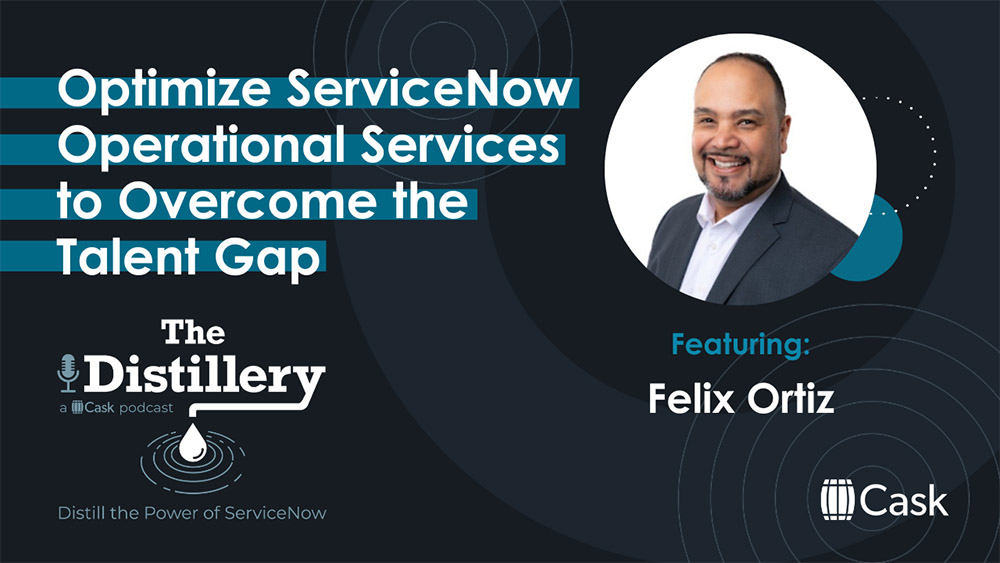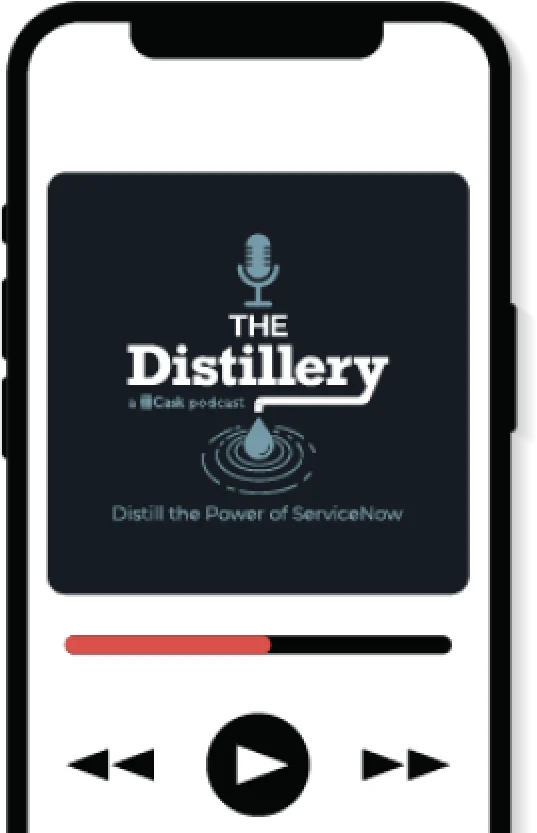Your Host:
Sean Dawson
Our Guest:
Felix Ortiz

Felix Ortiz, Cask's Principal Program Manager and Director of Operational Program Transformation, shares his wealth of experience in managing ServiceNow platforms. Uncover the common challenges platform owners face, from staffing challenges to the limitations of traditional outsourcing options. Discover the benefits of maintaining a 90-day backlog and learn how to proactively manage incoming demand. Dive into the critical role of platform governance and explore how Disciplined Agile can support continuous improvement. Whether you choose to manage your ServiceNow operations internally or leverage external expertise, this episode equips you with the strategies to optimize your operational services.
Sean Dawson: Hello once again, and welcome to the Cask Distillery Podcast, where we unlock the full potential of ServiceNow with expert insights and practical strategies, only here on the Cask Distillery Podcast. With me today is Felix Ortiz, who is our principal program manager and director of operational program transformation.
I have that right. Right, Felix?
Felix Ortiz: Yep. Operational program is the easiest way to say it: director of operational programs.
Sean Dawson: Awesome. And we don’t normally do this, but I would love for you to give a little quick intro of yourself and background.
Felix Ortiz: Sure. So, I’ve been around the ServiceNow ecosystem for well over 17 years. I started off as an early adopter, as a director for a biopharma where we implemented it at house. ServiceNow didn’t even have letters to their names when I started with that product. Switched over to consulting; did that for several years—solution architects from master presale support-type stuff. Switched over to sales for three years.
So you could see I’ve hopped around a lot in my career, all revolving around ServiceNow. And then for the last six, roughly, I’ve been in shared services, managed services, operational services in one manner or another in a director role.
Sean Dawson: Yeah. Yeah. I jumped around as well. I was in actually doing work and then in sales and marketing. I jumped around. So I can totally appreciate your background. But thanks for jumping on and taking the time.
And we want to talk about operational services today and dig into that a little bit. So, what do most platform owners struggle with in relation to managing the actual platform in your eyes?
Felix Ortiz: The irony of ironies is that when people or organizations establish a decision or make a decision to implement ServiceNow, they tend to neglect that, once ServiceNow is done, that they have a lot of work to do.
That’s just the beginning of the journey. So many organizations get to that point in their journey and say, “Well, what am I going to do to support it? And how am I going to support that?” And it encompasses everything, right? It revolves around taking the demand from their customer base. It’s stabilizing the environment. They get demands from ServiceNow themselves in terms of upgrades and patches. And not to mention the churn of the in and out of just needing to do reports forms and otherwise.
That tends to be—as simple as that seems—it’s a task in and of itself, and it just grows exponentially once you implement the solution. And most organizations don’t stay with just one portion of ServiceNow. You don’t do that. So as they grow with ServiceNow, all of a sudden, they realize that they have a lot to take care of from an operational perspective. They just underestimate that too many times.
Sean Dawson: Where do you see the talent shortage creating issues for clients right now?
Felix Ortiz: Around a lot of the specialized areas—CSM, HR, security operations—ITSM has become a common name for most organizations. And that’s where a lot of the strengths are from a talent-pool perspective. But even that has become difficult. Because as ServiceNow evolved and things have become more complex, a lot of the specializations around integrations, self-service capabilities, the thought leadership around how to leverage ServiceNow from an automation perspective, it’s that type of talent that’s really difficult to find.
Sean Dawson: Yep. And then when you think about it, you’re either bringing people in, or you’re trying to bring talent in. Do you see any issues with the traditional outsourcing options where they’re falling short at all?
Felix Ortiz: Yeah. The most common one is staff aug. When you think of that scenario and you think of how dynamic ServiceNow is, the simplest way to say it is that you bring someone in for one problem, but then as you evolve in ServiceNow, that person becomes not able to provide you the value you’re expecting right away, or it results in you having to switch people, which in and of itself is a challenge. So, from a consulting perspective, that used to work when you weren’t dealing with something as dynamic or as evolutionary as ServiceNow is in the way that they mature their platform.
Yeah, that’s the biggest problem in my opinion.
Sean Dawson: Yep. And then, because we’re talking about staffing and kind of keeping the platform going and getting help, it’s often that we want to—we usually recommend that people have a 90-day-deep backlog. But why is it important to have a 90-day-deep backlog?
Felix Ortiz: So, the 90-day lens, as I like to refer to it, is really one of those scenarios that really help organizations set a target for what they want to try to accomplish in those windows. A lot of talk revolves around road-mapping and strategic planning that goes two, three, and five years.
Well, things change way too much and way too rapid in that world of things to try to evolve a journey around ServiceNow that’s that far along. Now, you can do it at a very macro level, sure. But the reality is that the most important thing is taking it into a reasonable, digestible chunk, like 90 days. Trying to set a target for having a groomed backlog of 90 days of work. So that means requirements that are really vetted and ready to be consumed by the customers, and establishing that over a 90-day window. That provides a lot of value for an organization in terms of being able to do planning and organizing what type of talent they need and when they need it.
It also helps align the business who, usually, we end up having them join us when they have their “day jobs” too, right? So this helps in planning and organizing that as well.
You know, on the converse side of that, and an organization like ours, this helps us help them because when they have talent that they don’t have the specialized skills for, or they have a need that just happens to be outside of their wheelhouse, we can work with them proactively as opposed to reactively in staffing and supporting them against that lens.
Sean Dawson: Yeah. That really strikes a chord with me, when you think about what kind of talent and where to use. Because there’s a lot of times—I’m sure you’ve had these conversations—where they know they need help, but they don’t know who to bring in. They were able to help answer that, but it’s great for them to have that 90-day lens and know where and what to do and who to bring in. It’s a great way to do that.
So how can somebody proactively manage the demand incoming?
Felix Ortiz: So, there’s a lot of ways to do it. One of my backgrounds is in Agile. I’m a Disciplined Agile senior scrum master. And through that expertise, it allows me to be able to adapt Agile to align to a customer’s needs. What that translates to is that there’s a multitude of ways to actually gather the demand. And the way you manage that demand is ultimately the way you manage the growth of your backlog. Because that’s really where the rubber meets the road in terms of the 90-day lens. I think a lot of organizations know how to take a requirement that’s defined and get it through to production. And there’s a multitude of ways of doing that as well.
But the biggest exercise has to do with bringing the right type of consulting and conversations to the table around what type of demand there is, how to prioritize it, whether it’s something you should do or not—just because you can do something in ServiceNow doesn’t mean you should—and then ultimately get that into a backlog that’s 90-days deep.
The irony of all ironies is that in one specific requirement and one linear flow, that’s really easy to do. The challenge is that when you accumulate them over the 90-day window of planning, it becomes a really serious problem of prioritization and organizing, and it also becomes a problem of taking new demand that comes in and trying to feed it into that window.
Trying to keep that 90 days as 90ish as possible, if that makes sense, is the challenge.
Sean Dawson: All right. You had mentioned something you should or should not do within the platform. And that leads me to start thinking about platform governance and setting priorities. But how would you establish that in your platform?
Felix Ortiz: So, ironically enough, it has nothing to do with the platform and everything to do with the way you manage people. Because when you think of governance and you think of the requirements, the demands can come from anywhere. But having the right structure, having the right leadership over the right areas—so, give the example of incident, problem, and change manager, going back to old-school ITIL nomenclature, and of the process owners—having them know what the processes need to be and what they want those processes to be within an organization and then acting as that filter to say, “My customer wants X. That doesn’t meet my needs. So say no.” For some reason, saying no is a problem sometimes too.
So you need to go through the funneling process of taking all that demand, vetting it through the right process, through process, governance, and reviews. And then ultimately you get into the scenario where you have all of these requirements, all from competing areas of the business, and needing to come to consensus as to which one takes precedence over the other.
Sean Dawson: And you had mentioned something earlier, but I wanted to ask for the audience so they understand, is what is Disciplined Agile, and how does it support continuous improvement?
Felix Ortiz: So, Disciplined Agile is an Agile methodology that was established by the PMI (Project Management Institute), which basically takes all of the best of all the different types of Agile—so, Kanban, Agile Scrum, SAFe—and puts it into essentially one magic bag of tricks. (And I don’t want to hear any Felix the Cat jokes.) But the key there is that it allows you to kind of understand the best tools that are available from an Agile perspective and leverage them for the various types of work efforts that you do.
So Disciplined Agile has a structure around projects. Disciplined Agile has a recommendation around operational programs. And they have about seven or eight frameworks that all use Disciplined Agile tools as a basis to start from. When you join an organization, start a project of any type, start an operational program of any type, one of the first things you do is align the Disciplined Agile framework to what the business needs are. Get something in terms of consensus as to what you want to do and how you want to do it and you run with it from there.
Sean Dawson: Awesome. So to kind of wrap this up, I always like to ask, is there one thing that we didn’t cover that you’d like to share for those that are looking for operational services or want to know more about it?
Felix Ortiz: So, I think the most important thing to realize is that there’s a couple of ways to really support a customer. And Cask is very much about meeting you where you are. So, you know, whether you need an organization that really manages the entire demand to delivery lifecycle and deals with things from a level-one, level-two, level-three perspective and VAU enhancement plus governance, or if you just need to supplement a team with firepower that supports an existing team, whether it be a pod or individuals, we can do that. But ultimately, everything that we do within our services revolves around the Disciplined Agile framework and aligning that to your business needs to then deliver on operational services.
Sean Dawson: Awesome. Well, thanks again, Felix, for the time—I know how busy you are—and taking out time for the listeners. And speaking of listeners, I do want to ask you to like and subscribe and please provide us any suggestions—anything that you want to see. And we’ll see you again on the next Cask Distillery Podcast.
Take care. Bye bye.
We’re with you for what comes next
You're working in a rapidly shifting environment.
Global dynamics, AI advancements, heavy competition–the only certainty is change.
We get it. And we’re here to help you harness the full potential of ServiceNow to simplify transformation.
Let's navigate the future together.

Recent Episodes
We’re with you for what comes next
You're working in a rapidly shifting environment.
Global dynamics, AI advancements, heavy competition–the only certainty is change.
We get it. And we’re here to help you harness the full potential of ServiceNow to simplify transformation.
Let's navigate the future together.

Let’s Innovate Together!
Request a Complimentary Consultation from Cask.
Cask’s unparalleled expertise is ready to tackle your unique challenges and transform your aspirations into reality. We’ll listen to understand your requirements and offer a tailor-made approach that aligns with your strategic objectives.
Your journey to innovation is just a click away. Schedule your meeting with our Cask advisors and become part of the success story that defines your organization’s future.

Sign up for our Distillery Podcast
Stay up to date with the latest episodes







